The Yatenga region of West Africa is home to many bird species. From the area’s abundant grasslands, woodlands, and wetlands, these birds of prey, songbirds, and waterfowl provide a stunning display of colors and sounds.
Whether you are an experienced birdwatcher or just starting, Yatenga will indeed offer a unique birding experience. The region is home to various endemic and migratory species and rare sightings of some of the more elusive birds.
With its diverse habitats and range of birds, Yatenga is a paradise for birders.
24 Birds to Watch in Yatenga
Yatenga is a province of Burkina Faso, located in the Nord Region of the country. It is home to a rich diversity of birdlife, thanks to its varied savanna, woodland, wetland, and farmland habitats.
Here are 24 birds that you can look for in Yatenga.
1. Common Ostrich
The common ostrich is a large, flightless bird native to Africa. It is the largest living bird species, reaching up to 9 feet in height and weighing up to 320 pounds.
Ostriches have long legs and a long neck, with a mostly bald head and a beak that is curved and sharp. They have two toes on each foot, which is unusual for birds. The common ostrich is the only living member of Struthio, part of the ratite order of birds.
This order of birds comprises birds that cannot fly, such as emu, rhea, cassowary, and kiwi. The common ostrich is found in sub-Saharan Africa, where it feeds on plants, seeds, shrubs, insects, and other small animals.
They live in groups called flocks, and the male acts as the protector of the flock. They can run up to 43 miles per hour, making them one of the fastest two-legged animals on land.
Ostriches can also kick with great force, making them quite dangerous if threatened. These birds have been domesticated and are now used for their feathers, meat, and eggs.
| Kingdom | Animalia |
| Phylum | Chordata |
| Class | Aves |
| Order | Struthioniformes |
| Family | Struthionidae |
| Genus | Struthio |
| Species | S. camelus |
2. Black Bellied Plover
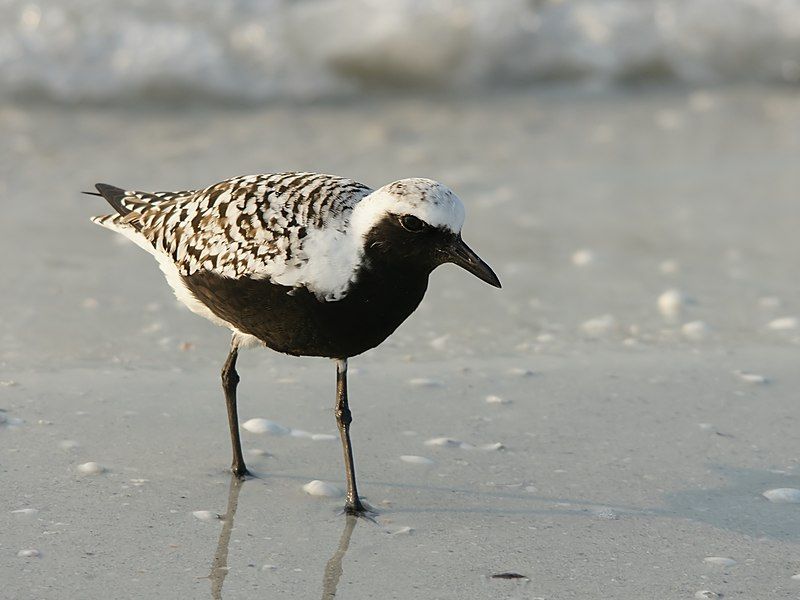
The Grey Plover is a species of large bird that can be found in many areas across the world. It is also known as the Black-bellied Plover in North America. This species of bird breeds in Arctic regions and is a long-distance migrant.
This means it can be found in many coastal areas worldwide when it is not breeding.
During the breeding season, they migrate to Arctic regions to raise their young. The Grey Plover is a species of bird that can thrive in many different environments on a global scale.
This adaptation has allowed them to survive in many different habitats and climates. They are essential to many ecosystems, playing a vital role in the food web.
They are also significant to humans and used for recreational activities such as bird watching and hunting.
| Kingdom | Animalia |
| Phylum | Chordata |
| Class | Aves |
| Order | Charadriiformes |
| Family | Charadriidae |
| Genus | Pluvialis |
| Species | P. squatarola |
3. Great Cormorant
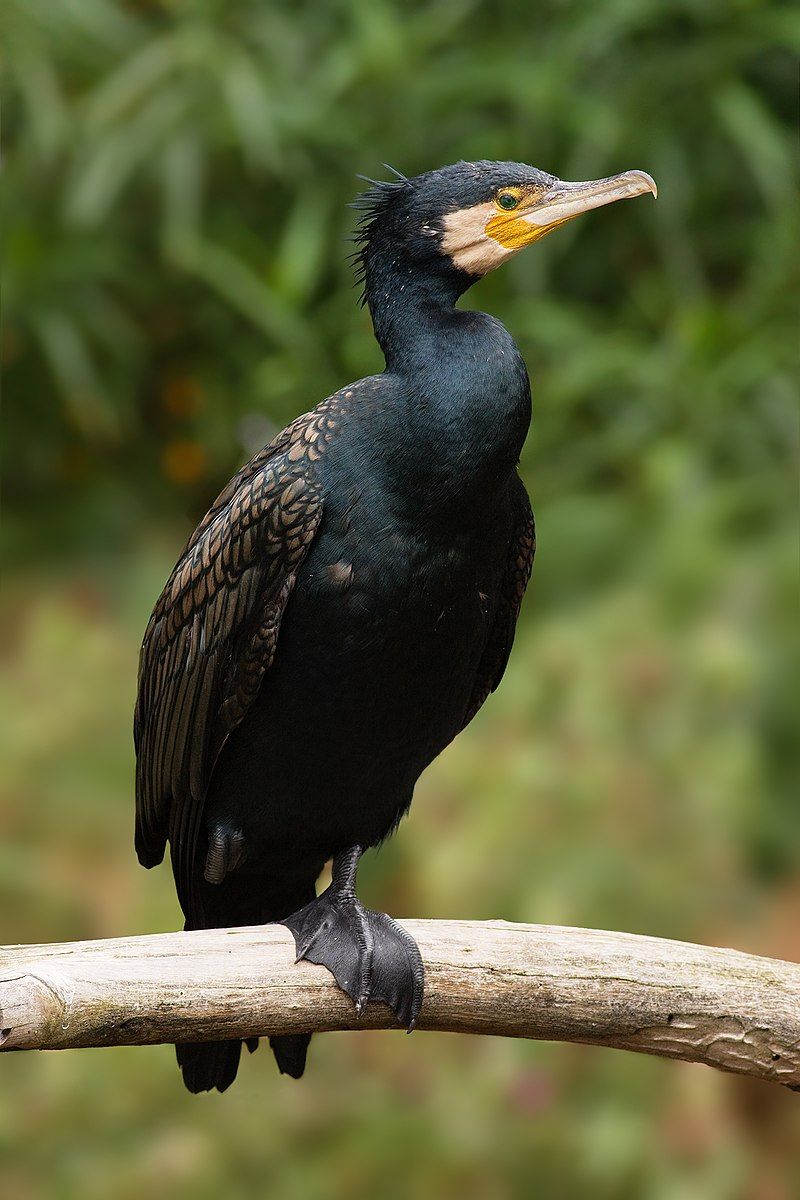
The great cormorant is a species of seabird found across the Northern Hemisphere. It is known by various names depending on the location, for example, in New Zealand it is known as the black shag or kawau, in Australia as the black cormorant, and in India as the large cormorant.
Its dark feathers and long neck recognize this bird, which is widely distributed in various bodies of water, including oceans, rivers, lakes, and other wetlands. It feeds mainly on fish and crustaceans, which it captures by diving underwater in pursuit.
It is also known for its robust and rapid wing beats during flight, and it often perches on rocks near the water’s edge to dry its feathers after swimming.
The great cormorant is an essential species in the ecosystem, playing a vital role in controlling the populations of fish and other aquatic species.
| Kingdom | Animalia |
| Phylum | Chordata |
| Class | Aves |
| Order | Suliformes |
| Family | Phalacrocoracidae |
| Genus | Phalacrocorax |
| Species | P. carbo |
4. African Crake
The African crake is a species of bird belonging to the rail family, native to many regions of central and southern Africa. This species is typically small to medium-sized, and it is found living on the ground.
It is a seasonal resident in most of its range, except for rainforest areas and regions with low annual rainfall. The African crake is a shy yet bold bird who often runs away quickly when disturbed.
It prefers open grassy areas and is known to inhabit pastures, meadows, and farmlands. It may often be found near water sources, such as rivers, streams, lakes, and ponds.
The African crake’s diet consists mainly of insects, spiders, and small invertebrates, and it will also eat seeds, berries, and other plant matter.
The African crake is not considered to be threatened, although it may be locally vulnerable to habitat destruction, hunting and trapping, and other forms of human activity.
Conservation efforts are needed to ensure this species’ long-term survival.
| Kingdom | Animalia |
| Phylum | Chordata |
| Class | Aves |
| Order | Gruiformes |
| Family | Rallidae |
| Genus | Crecopsis |
| Species | C. egregia |
5. Black Crowned Crane
The black-crowned crane is a member of the family Gruidae, which also includes its sister species, the grey-crowned crane. These two species are large birds, with the black-crowned crane up to 1.5 meters tall.
The distinguishing feature of the black-crowned crane is the golden crown of bristle-like feathers atop its head. This bristle-feathered crown gives the black-crowned crane its name, as it stands out from the rest of the birds in the family.
The black-crowned crane can be found in the wetlands and grasslands of Africa, where it is known for its graceful and elegant movements. Due to its declining population, it is a protected species and can be found in the wild in several African countries.
The black crowned crane is an essential symbol in many African cultures and is often seen in art and folklore.
| Kingdom | Animalia |
| Phylum | Chordata |
| Class | Aves |
| Order | Gruiformes |
| Family | Gruidae |
| Genus | Balearica |
| Species | B. pavonina |
6. Black-winged Stilt
The black-winged stilt is a species of wader related to the avocet and stilt families that can be found worldwide. Its scientific name is H. himantopus.
It is distinguished from other species of its family by its long legs, which give it a unique appearance. The black-winged stilt is a famous bird among birdwatchers and photographers, often seen in wetlands and near water sources.
Its diet mainly comprises small aquatic invertebrates such as insects, mollusks, and crustaceans.
It is also known to eat small fish and amphibians. The black-winged stilt has a wingspan of up to 80 centimeters and can be found in habitats ranging from shallow wetlands to deeper bodies of water.
It is an important species for maintaining the health of aquatic ecosystems, as it helps control insect populations and provides food for larger predators. The black-winged stilt is a migratory species, with some populations moving south for the winter.
Its migratory routes may take it across hundreds of miles, and it has been sighted in Europe, Africa, Asia, and Australia. The black-winged stilt is an essential species for its ecosystem, as it helps control insect populations and provides food for larger predators.
It is also a beautiful species, with its unique long-legged appearance and black-and-white coloration. Conservation efforts to protect the species are essential to ensure its continued survival.
| Kingdom | Animalia |
| Phylum | Chordata |
| Class | Aves |
| Order | Charadriiformes |
| Family | Recurvirostridae |
| Genus | Himantopus |
| Species | H. himantopus |
7. Helmeted Guineafowl
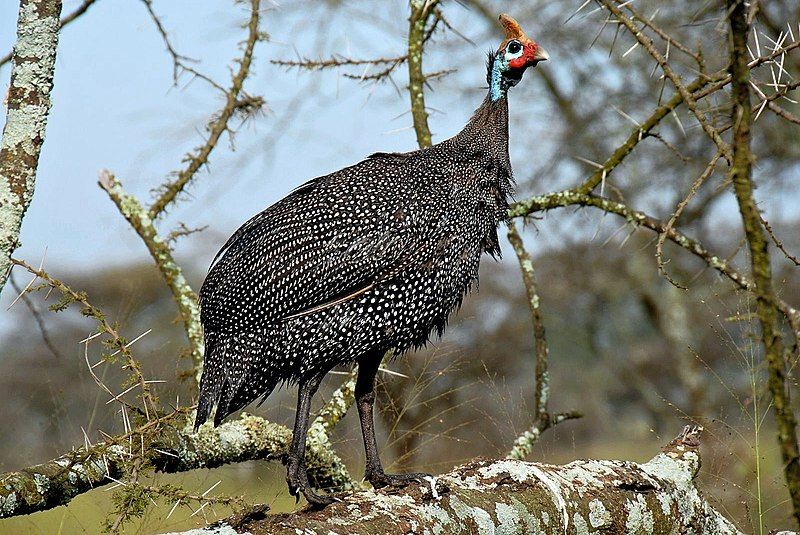
The helmeted guineafowl is the most recognizable member of the Numididae family of birds and the only one in the Numida genus. Native to Africa, mainly south of the Sahara, the helmeted guineafowl has been successfully introduced to numerous other parts of the world.
It is now a domesticated species in the West Indies, North America, Colombia, Brazil, Australia, and Europe. The helmeted guineafowl is a medium-sized bird with a distinctive round, helmet-like headpiece comprising two rows of spiky feathers.
Its body is covered in grey-black feathers, with a white-speckled abdomen. They are usually found in small flocks, on open grassland, and can fly short distances. The helmeted guineafowl is omnivorous, eating various plants, insects, and small animals.
They also have a solid pecking instinct, which means they will often pick food off the ground. They are a hardy species with a long lifespan and the ability to survive in various climates and terrains. The helmeted guineafowl is an important species for humans.
Domesticated birds are often kept for their meat, eggs, and feathers. They are also frequently used as pets and can form strong bonds with their owners.
The wild birds are also important, as they help to keep insect and rodent populations in check. Overall, the helmeted guineafowl is a unique and fascinating species.
Its natural range has been extended due to its successful introduction into other parts of the world, and its importance to humans continues to be recognized.
| Kingdom | Animalia |
| Phylum | Chordata |
| Class | Aves |
| Order | Galliformes |
| Family | Numididae |
| Genus | Numida |
| Species | N. meleagris |
8. Little Grebe
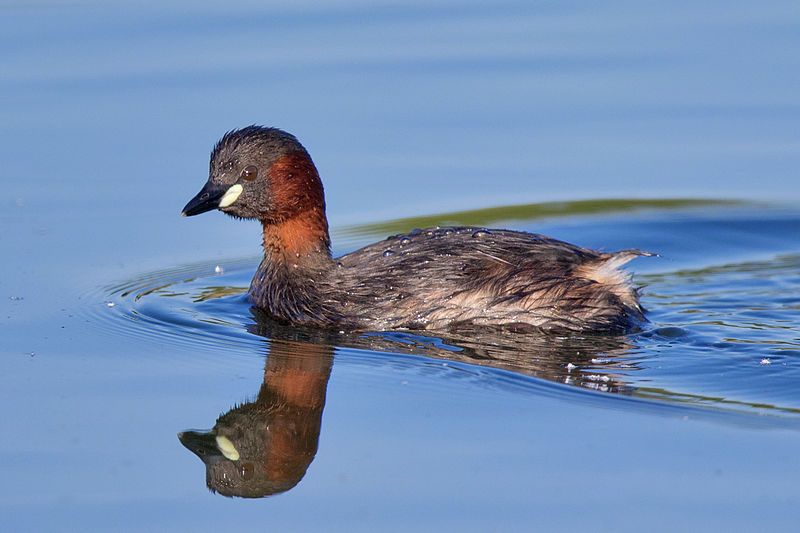
The little grebe, also known as dabchick, is a member of the grebe family of water birds. This family of birds is so named because its genus name is derived from the Ancient Greek takhus, which means “fast”, and bap to, which means “to sink under”.
The specific ruficollis is also derived from Latin, with Rufus meaning “red” and -collis meaning “-necked”, which is derived from collum, which means “neck”. This species of bird is, therefore, characterized by its red neck.
The grebe family of birds is well-known for being swift and able to sink underwater quickly, as its genus name suggests. This family is also known for being excellent swimmers and divers, and they prefer to live in freshwater bodies such as lakes and ponds.
| Kingdom | Animalia |
| Phylum | Chordata |
| Class | Aves |
| Order | Podicipediformes |
| Family | Podicipedidae |
| Genus | Tachybaptus |
| Species | T. ruficollis |
9. Whimbrel
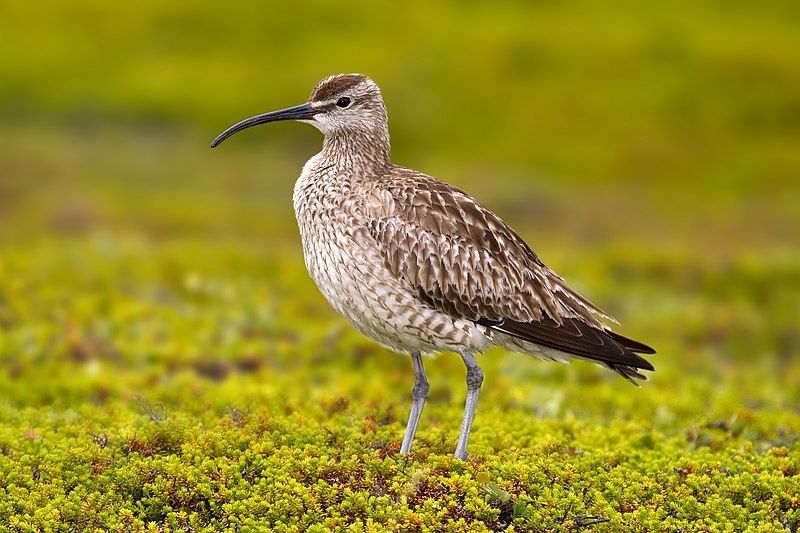
The Eurasian or common whimbrel is a type of water bird that belongs to the Scolopacidae family. It is a species of curlew found in many parts of the world, but it is commonly called the white-rumped whimbrel in North America.
The whimbrel breeds across much of subarctic Asia and Europe, extending south of Scotland. It has adapted to various habitats, from estuaries and tidal flats to mudflats and beaches. It feeds primarily on crustaceans, mollusks, and insects.
The whimbrel is a migratory species, spending the summer months in the northernmost parts of its range before migrating south in the winter.
In terms of physical characteristics, the whimbrel is a medium-sized shorebird with a mottled brown back and wings, a white breast, and a white rump that gives it its North American name. Its bill is long and curved, and it has slaty gray legs.
The whimbrel is impressive, often soaring high up in the sky or gliding gracefully over the water. The Eurasian or common whimbrel is an important species to many ecosystems, both as predator and prey.
It plays a vital role in maintaining the balance of nature by preying on invertebrates and providing food for other predators, such as foxes and owls.
In addition, it serves as an important indicator species, as its presence or absence in an area can provide valuable information about the environment’s health.
| Kingdom | Animalia |
| Phylum | Chordata |
| Class | Aves |
| Order | Charadriiformes |
| Family | Scolopacidae |
| Genus | Numenius |
| Species | N. phaeopus |
10. Isabelline Shrike
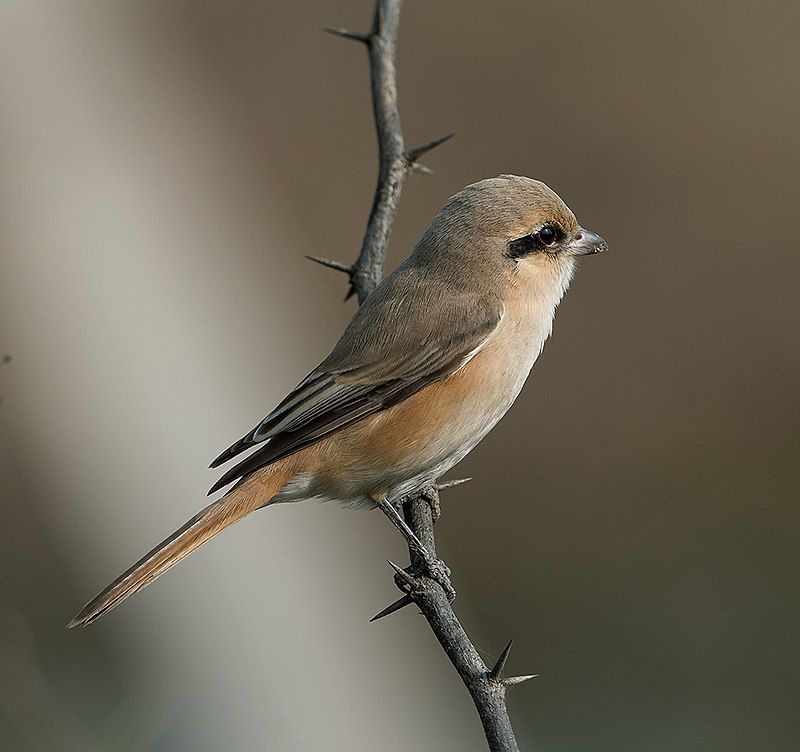
The Isabelline Shrike, also known as the Daurian Shrike, is a bird species belonging to the Shrike family. It is found over an extensive range, which stretches from the Caspian Sea to the Qaidam Basin in northern and central China.
This species was previously classified as the same as the Red-backed Shrike and Red-tailed Shrike, but recent studies have identified it as a distinct species.
During the winter months, the Isabelline Shrike migrates to Africa and Arabia from its breeding grounds in the east. This bird species has drab, sandy-brown plumage with a white underside to its wings. The Isabelline Shrike also has a black tail and striking yellow eyes.
Its diet consists of insects and other small invertebrates, which it hunts from the branches of trees and shrubs. In addition to this, the Isabelline Shrike has been known to take small reptiles, amphibians, and even small mammals.
It is an elusive species and is rarely seen by humans. The Isabelline Shrike has a variety of calls, such as harsh chattering, and its flight is usually swift and direct. The species is believed to form monogamous pairs and breed in the springtime.
The nest is constructed from twigs and grass and is usually built in a bush or small tree. The female lays a clutch of four or five eggs, which are incubated for 13-15 days before hatching. Both parents feed the young before they leave the nest after around 17-19 days.
The Isabelline Shrike is listed as a species of Least Concern by the IUCN due to its wide distribution and assumed sizeable overall population.
However, its population is thought to be declining due to the destruction of its natural habitats for agricultural and industrial development. Conservation efforts are currently in place to protect this species.
| Kingdom | Animalia |
| Phylum | Chordata |
| Class | Aves |
| Order | Passeriformes |
| Family | Laniidae |
| Genus | Lanius |
| Species | L. isabellinus |
11. Egyptian Plover
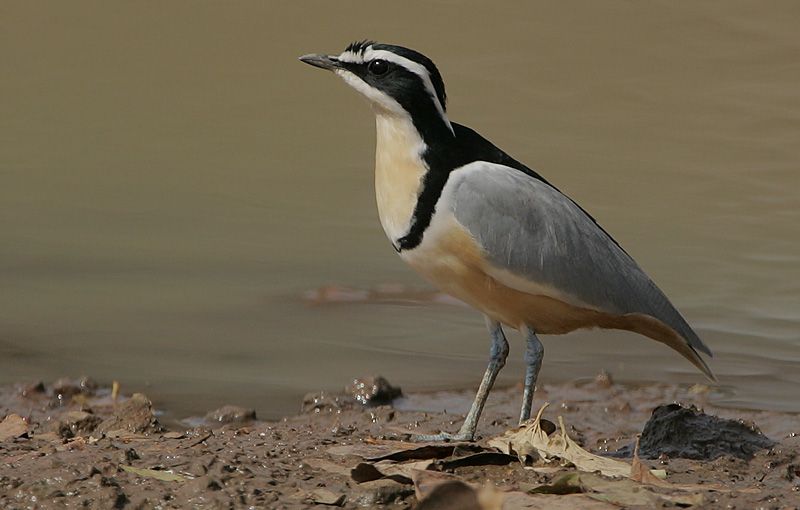
The Egyptian Plover is a unique bird, also known as the crocodile bird. It is the only member of its genus, Pluvianus, formerly classified in the pratincole and courser family, Glareolidae.
However, due to its distinctiveness, the Egyptian Plover is now recognized as the sole member of its own monotypic family, Pluvianidae. This bird is a wader, meaning it spends its time in shallow water, riverbanks, mud flats, and lakeshores.
It is a small-sized bird with black and white plumage and a long, down-curved bill. It lives in Africa and the Middle East and feeds mainly on insects, spiders, and small fish.
Despite its small size, the Egyptian Plover is an integral part of the ecosystem, providing food for larger predators and helping to keep the insect population in check.
| Kingdom | Animalia |
| Phylum | Chordata |
| Class | Aves |
| Order | Charadriiformes |
| Family | Pluvianidae |
| Genus | Pluvianus |
| Species | P. aegyptius |
12. African Darter
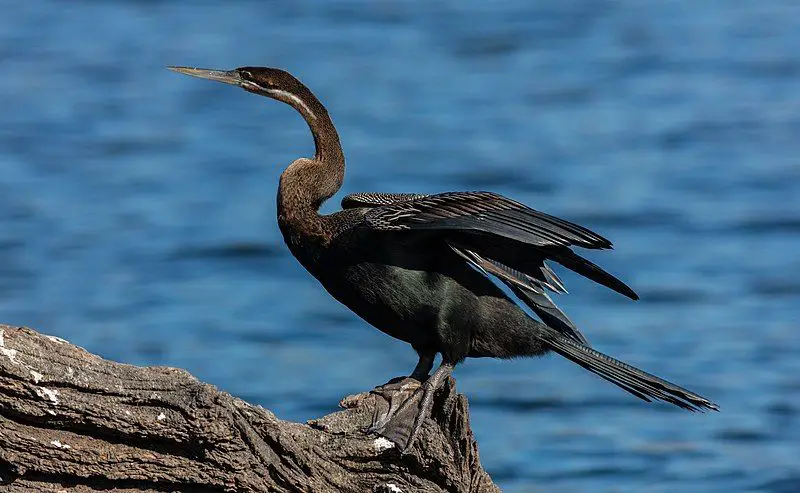
The African darter, also known as the snakebird, is a unique species of bird found in sub-Saharan Africa and Iraq. It is a water bird, which means it is well adapted to living in and around bodies of water, such as rivers, lakes, and marshes.
It is recognizable by its long, slender neck and its curved bill. The African darter has a wide wingspan, usually 60 and 70 cm, and a long tail that can reach up to 15 cm in length.
It is an expert swimmer and can often be seen floating on the water’s surface with just its neck and head exposed. The African darter feeds mainly on fish, which it catches by diving into the water and pursuing its prey.
Its curved bill is well-suited for grabbing hold of slippery fish. It also feeds on insects, crustaceans, and small amphibians. During the breeding season, the African darter builds a platform nest on the branches of trees or artificial structures near water.
Both parents take part in the incubation of the eggs and in caring for the chicks. The African darter is a fascinating bird well adapted to life near water.
Its long neck and curved bill make it a formidable hunter, and its wide wingspan helps it stay aloft while searching for food. It is a beautiful bird that deserves greater recognition and protection.
| Kingdom | Animalia |
| Phylum | Chordata |
| Class | Aves |
| Order | Suliformes |
| Family | Anhingidae |
| Genus | Anhinga |
| Species | A. rufa |
13. Arabian Bustard
The Arabian bustard is a bird species in the bustard family, native to the Sahel region of Africa and southwestern Arabia. It is part of the large-bodied genus Ardeotis and is a typical species in that group.
This bird is relatively unknown but has several features that make it an interesting species. Its population is likely to be larger than other bustards, as it has a wide range of habitats and an extensive range.
It is also a ground-dwelling species living in open woodlands, grasslands, and scrubland. It prefers to feed on insects, small mammals, and reptiles, and its diet varies.
It is also known to have a strong pair bond, and the male is often seen performing courtship displays to attract a mate. The Arabian bustard is an essential species in its range and is a keystone species that helps maintain the balance of the local ecosystems.
| Kingdom | Animalia |
| Phylum | Chordata |
| Class | Aves |
| Order | Otidiformes |
| Family | Otididae |
| Genus | Ardeotis |
| Species | A. arabs |
14. Chestnut-bellied Sandgrouse
The chestnut-bellied sandgrouse, or common sandgrouse, is a species of sandgrouse that is found in a variety of different habitats.
It is a sedentary species, meaning it generally stays in one area but has a nomadic tendency, meaning it can migrate between different regions. The chestnut-bellied sandgrouse is native to northern and central Africa and western and southern Asia.
This species has six distinct subspecies, all of which have slightly different physical characteristics and habitats. For example, the northernmost subspecies is the African chestnut-bellied sandgrouse, which can be found in the Sahel region of Africa.
This subspecies is paler in color than other subspecies and is usually found in dry savannah habitats. In comparison, the westernmost subspecies is the Indian chestnut-bellied sandgrouse, which is much darker and is generally found in grasslands and scrubland habitats.
All six subspecies of the chestnut-bellied sandgrouse have adapted to their respective habitats and have evolved to survive in the challenging environment of their region.
| Kingdom | Animalia |
| Phylum | Chordata |
| Class | Aves |
| Order | Pterocliformes |
| Family | Pteroclidae |
| Genus | Pterocles |
| Species | P. exustus |
15. Coqui Francolin
The Coqui Francolin is an impressive species of bird found in the family Phasianidae. Native to the African continent, the Coqui Francolin is a medium-sized gamebird with black and white speckled plumage and a red bill.
The Coqui Francolin is a terrestrial species, and it is usually found in grassy savannahs and open woodlands. It is an omnivore, feeding on various insects, seeds, and other plant material.
This species is also an important food source for many predators, including raptors, cats, and mongooses. The Coqui Francolin typically lives in small groups of two to five birds and is a pretty vocal species.
Its distinctive call is a loud, rasping “coqui” sound often heard in the early morning and late evening. The species is highly territorial, and males often use a variety of calls and displays to establish and defend their territories.
Breeding usually occurs between April and June; the female typically lays three to four eggs in a grass-lined nest.
The chicks can leave the nest after around ten days but remain with their parents until the end of the breeding season.
The Coqui Francolin is currently listed as “Least Concern” on the IUCN Red List, but its population is in decline due to habitat destruction and hunting pressure.
Conservation efforts are needed to ensure the future of this unique species.
| Kingdom | Animalia |
| Phylum | Chordata |
| Class | Aves |
| Order | Galliformes |
| Family | Phasianidae |
| Genus | Campocolinus |
| Species | C. coqui |
16. Grey-headed Gull
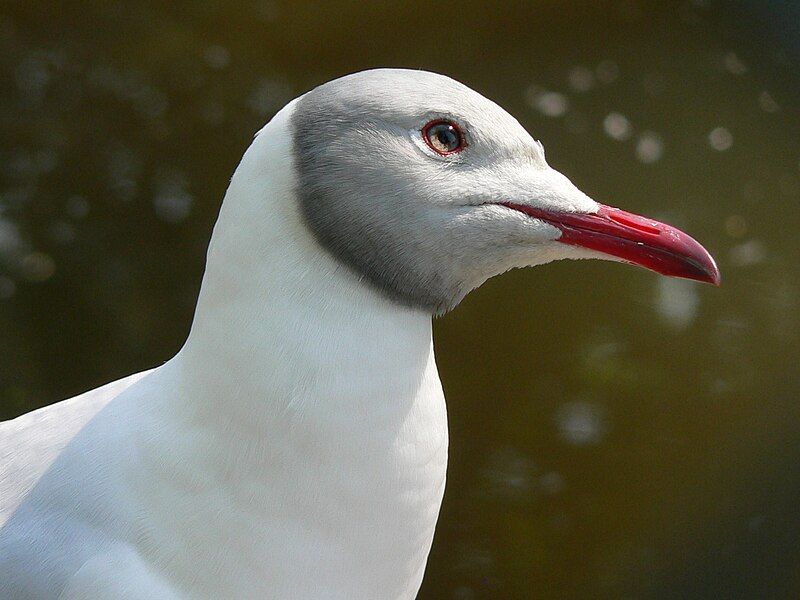
The grey-headed gull, also known as the gray-hooded gull, is a small species in and around South America and Africa, south of the Sahara. It is not migratory, but its range expands during winter.
This gull species has been recorded as a rare vagrant in North America, Italy, and Spain. The grey-headed gull is particularly unique due to its unusual habitat. While some species of gulls are migratory, this species remains relatively stationary throughout the year.
However, it does expand its range in the winter, which could result from a search for food sources or changes in environmental conditions. In terms of appearance, the grey-headed gull is easily distinguishable from other gull species due to its distinctive grey hood.
This species also has a yellow bill and legs and brownish-gray upperparts. In terms of behavior, the grey-headed gull is a quiet species often seen in small groups or pairs. They feed predominantly on insects, larvae, worms, mollusks, and crustaceans.
They have also been known to scavenge for food in dumps or other areas with abundant scraps. Overall, the grey-headed gull is an exciting species with an unusual range and habitat.
It is a species that can be seen in various places, from South America to North America and, in some cases, even Europe. It is also a species adapted to different habitats, from coastal areas to open fields and urban areas.
| Kingdom | Animalia |
| Phylum | Chordata |
| Class | Aves |
| Order | Charadriiformes |
| Family | Laridae |
| Genus | Chroicocephalus |
| Species | C. cirrocephalus |
17. Greater Painted-snipe
The greater painted-snipe is a wading bird species belonging to the family Rostratulidae. It is found in various African, South, and Southeast Asian regions and lives in marshes and other wetlands.
This bird species is characterized by its unique physical features, such as its long bill and long legs. The greater painted-snipe has a black and white patterned plumage, dark feathers on its head, neck, and chest, and a white belly.
It also has a yellow-tipped tail and long, yellow legs. The greater painted-snipe is an omnivore, with its diet mainly consisting of small aquatic invertebrates, such as insects, crustaceans, and mollusks.
It also eats small amphibians, reptiles, fish, and some plant material. The greater painted snipe is a solitary bird, usually living alone or in small groups of up to four individuals.
It is usually seen in shallow wetlands, where it forages for food in the mud and water. The greater painted snipe is a species of conservation concern, as its populations have been decreasing due to habitat loss and degradation.
Its range has also been affected by environmental changes, and it is now considered vulnerable to extinction. Conservation efforts aim to protect the bird’s habitats and encourage its natural reproduction.
| Kingdom | Animalia |
| Phylum | Chordata |
| Class | Aves |
| Order | Charadriiformes |
| Family | Rostratulidae |
| Genus | Rostratula |
| Species | R. benghalensis |
18. Lesser Jacana

The lesser jacana is a type of bird in the Jacanidae family of wading birds. It is the only species in the genus Microparra, making it monotypic. This means that the lesser jacana is the only bird species in the genus Microparra, and there are no other species in the same genus.
The lesser jacana is found in tropical and subtropical parts of Africa, Asia, and South America, living in wetland habitats such as marshes, swamps, lakes, and lagoons.
They feed on aquatic insects, larvae, and other small invertebrates, which they find in the shallow waters they inhabit. The lesser jacana is a small bird with a length of about 12 inches, usually brown or gray.
They have long legs and webbed feet, which help them to walk on floating vegetation in the water. They have a distinctive black bill and a yellow-tipped crest. The lesser jacana is a common bird species and is not currently threatened.
| Kingdom | Animalia |
| Phylum | Chordata |
| Class | Aves |
| Order | Charadriiformes |
| Family | Jacanidae |
| Genus | Microparra |
| Species | M. capensis |
19. Pennant-winged Nightjar
The pennant-winged nightjar is found across various African countries, from Nigeria to northern South Africa. This species is an intra-African migrant, meaning it migrates within the continent rather than between continents.
During the breeding season, this species displays remarkable sexual dimorphism, meaning there are distinct physical differences between males and females.
For example, the males have a crest on their head and a reddish-orange patch of feathers on their wings, while the females have a brownish-grey patch. These differences make them easier to identify in the wild.
| Kingdom | Animalia |
| Phylum | Chordata |
| Class | Aves |
| Clade | Strisores |
| Order | Caprimulgiformes |
| Family | Caprimulgidae |
| Genus | Caprimulgus |
| Species | C. vexillarius |
20. Red-chested Flufftail
The red-chested flufftail is a unique species of bird native to sub-Saharan Africa, found in countries from Liberia to Ethiopia and south to South Africa. This bird species belongs to the Sarothruridae family and is easily identifiable by its distinctive red chest.
The red-chested flufftail is a relatively small bird, measuring between 16 and 18 centimeters in length. It has a rounded head, short neck, and brief, rounded wings.
The back and wings are dark gray, and the underparts are white with a patch of bright red feathers on the chest.
The flufftail also has a short, dark tail with white outer feathers. The red-chested flufftail is a shy, insectivorous bird that prefers to stay hidden in dense vegetation.
It is primarily active at night, and during the day, it roosts in thick vegetation, such as dense grass or shrubs, where it isn’t easy to spot.
Its diet includes invertebrates, such as beetles, ants, and caterpillars. The red-chested flufftail is an elusive bird and is rarely seen by birdwatchers.
It is listed as an endangered species due to its limited habitat range and the destruction of its natural habitat by human activities, such as agricultural expansion and urban development.
Conservation efforts are underway to protect the remaining populations of this species.
| Kingdom | Animalia |
| Phylum | Chordata |
| Class | Aves |
| Order | Gruiformes |
| Family | Sarothruridae |
| Genus | Sarothrura |
| Species | S. rufa |
21. Senegal Coucal
The Senegal coucal is a bird belonging to the Cuculiformes, a scientific order of birds that includes many different species. This order includes birds such as roadrunners, anis, and hoatzin. The Senegal coucal is a medium-sized bird within its genus.
It is typically found inhabiting lightly wooded country and savannah regions in central and southern Africa. The Senegal coucal is a large bird, ranging in size between 24 and 29 centimeters in length, with a wingspan of up to 50 centimeters.
It has a dark brown and black body with a white throat and breast. It has reddish-brown eyes, a greyish-black beak, and a long, dark tail.
The Senegal coucal mainly feeds on insects, small reptiles, and mammals. The Senegal coucal is primarily found in lightly wooded country and savannah regions in central and southern Africa. It is a shy and secretive bird that usually nests in dense vegetation.
They are usually found in pairs or small groups and are known to be quite vocal birds with loud calls. The Senegal coucal plays an essential role in its environment since it helps to keep insects and other small animals in check.
It is also an important food source for many predators, including owls and hawks. The Senegal coucal is listed as a species of most minor concern by the International Union for Conservation of Nature (IUCN).
Despite this, it faces habitat destruction and degradation threats and is being hunted for its feathers and meat.
| Kingdom | Animalia |
| Phylum | Chordata |
| Class | Aves |
| Order | Cuculiformes |
| Family | Cuculidae |
| Genus | Centropus |
| Species | C. senegalensis |
22. Common Buttonquail
The common buttonquail, known as the Hurricane buttonquail, small buttonquail, or Andalusian hemipode, is a species of ground-dwelling bird belonging to the buttonquail family.
This family is part of the order Gruiformes and is not related to the true quails despite their similarities in appearance. Buttonquails are typically small birds, measuring 4.7 to 5.5 inches long and weighing just 0.5 to 0.7 ounces.
They have a short, stout bill and brownish-grey feathers, which help them blend in with their surroundings. These birds eat small insects, seeds, and other invertebrates commonly found in dry grasslands and scrublands.
They also nest on the ground, using grass and leaves to construct their nests. Buttonquails are monogamous birds, with pairs typically staying together for life.
The common buttonquail is native to Africa, the Middle East, and some parts of Europe and is considered an essential part of the ecosystem in these areas.
| Kingdom | Animalia |
| Phylum | Chordata |
| Class | Aves |
| Order | Charadriiformes |
| Family | Turnicidae |
| Genus | Turnix |
| Species | T. sylvaticus |
23. Stone Partridge
The stone partridge is a species of bird belonging to the New World quail family. It is a predominantly brown bird often seen with its tail raised. It is mainly found in scrublands and lightly wooded habitats and is often seen near rocks.
The range of the stone partridge extends from Kenya and Ethiopia to Gambia. The stone partridge is a solitary bird and is most active in the early morning and late evening when looking for food.
Its main diet consists of insects, grass seeds, and small fruits. It is an alert species that will sound an alarm when it senses any danger. The stone partridge builds its nests in small depressions in the ground. It is known to lay up to 16 eggs.
The chicks can fly after 16 days of hatching. The stone partridge is a shy species rarely seen in open areas. The stone partridge is an essential species in its ecosystem, as it helps control the insect population.
It is also a famous game bird and is hunted for its meat. Despite being hunted, the stone partridge is considered to be of least concern by the IUCN.
| Kingdom | Animalia |
| Phylum | Chordata |
| Class | Aves |
| Order | Galliformes |
| Family | Odontophoridae |
| Genus | Ptilopachus |
| Species | P. petrosus |
24. Violet Turaco
The violet turaco is a species of bird native to Africa and is a member of the turaco family. This species is also known as the violaceous plantain eater due to its diet, mainly composed of plantains and other fruits.
It is a large bird with a wingspan of up to 40 inches and is usually found in tropical and subtropical forests. The violet turaco is a very colorful bird, with its feathers combining purple, blue, yellow, and green.
It has a distinctive crest on its head and a long red tail. The turacos, along with the cuckoos, form the group of African birds known as the otidimorphae. They are closely related to each other and share many common characteristics.
The turacos are known for their distinctive calls and loud and beautiful songs.
They are also able to fly long distances and move between different habitats. The violet turaco is an essential species for the African ecosystem, as it helps disperse the seeds of the fruits it eats.
It is also a popular species for bird watchers, as it is relatively easy to spot in its natural habitat.
| Kingdom | Animalia |
| Phylum | Chordata |
| Class | Aves |
| Order | Musophagiformes |
| Family | Musophagidae |
| Genus | Musophaga |
| Species | M. violacea |
Conclusion
Birds are a vital part of Yatenga’s ecosystems, providing food for people and wildlife, helping to pollinate crops, and playing an essential role in maintaining the balance of nature.
The birds of Yatenga are a precious resource, and our responsibility is to ensure their protection and conservation for generations to come.